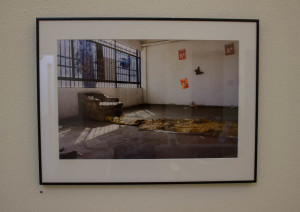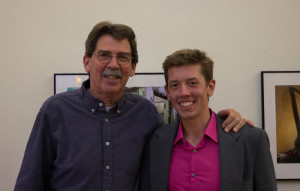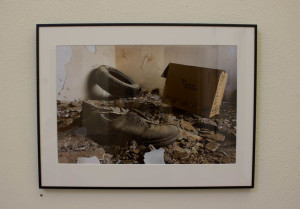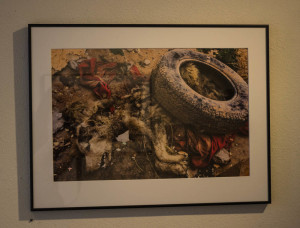Tags
Related Posts
Share This
Montavon’s Desaparecidos
In a former department store on Avenida Vicente Guerro in Juárez, Mexico, insulation lies on the ground like a blanket. A boot is nailed into the wall. The broken soles of a child’s doll protrude from the rubble of a demolished warehouse on Boulevard Oscar Flores. In an empty housing project, the remains of a taxi sit idle in the street. Garbage gathers in piles inside the empty pharmacy on Avenida 16 de Septiembre, a favorite squatting site for local heroin addicts. Sunlight casts lonely shadows through the windows, illuminating an array of “Missing” posters plastered on the glass. In what was once a family bedroom in Colonia Paraje de San Jose, orange handprints and footprints of forgotten children stand out against a blue wall.
“I must have looked at the wall for 20 minutes before I shot that photograph,” says photographer Luke Montavon at the May 1 opening of his senior thesis show at SFUAD’s Marion Center for Photographic Arts. The show, which features a series of photographs taken by Montavon over three years, depicts the devastation and abandonment wrought by the drug war in Juárez, Mexico. The title of the show, Desaparecidos, means “missing persons” in Spanish.
Between 2007 and 2011, an estimated 450,000 people fled the city of Juárez, escaping the violent turf war between the Juarez and Sinaloa drug cartels. “I tried to imagine what happened there,” Montavon says. “They wanted to mark their family’s presence. That’s how I tried to build the story. Without a story, it’s just a bunch of clichéd images of abandoned buildings. Having an understanding of why these buildings are the way they are makes the pictures so much more enriching.”
Montavon nearly fell through a deteriorating floor in one building. On another occasion, he was nearly arrested, robbed and stabbed within the space of an hour. “So many elements were out of my control,” Montavon says. During his three separate trips to Mexico, Montavon stayed with guides whom he met online. Without a comprehensive understanding of the language, he had to trust that the guides knew what they were doing.
Photography Department Chair Tony O’Brien gave Montavon a couple of contacts in Juárez before he made his trip. He applauds Montavon for his courage in venturing into the dangerous city. The police stopped Montavon on one of the few occasions that he ventured out without his guides. “I later found out I was in an area where a lot of heroin addicts go to shoot up,” Montavon says.
Though the drug war is hardly at an end, the violence in Juárez began to die down with the victory of the Sinaloa cartel over the Juárez cartel in early 2010. Former residents have begun trickling back into the city, but Juárez is far from recovered. In Colonia Paraje de San Jose, a mother of five raises her children amid blocks of abandoned homes. An excessive amount of bullet holes mar the wall behind a home in the neighborhood of Colina Los Arcos. “It’s really not clear what happened there,” Montavon says. “Based on what I was told, it was more than likely something involving the drug trade. When the narcos took over, they demanded taxes from the people living there. Maybe the narcos had to leave in a rush and there were people they needed to kill. Maybe it was a family that got dragged out and killed in the middle of the night. It’s hard to tell.”
Montavon’s installation concludes with the image of several doorways within a large, family home. Plastic containers litter the floor and the wooden beams of the ceiling are exposed. “Some people still live in these areas,” Montavon says. “The infrastructure for waste disposal is not like it is here in the U.S. A lot of the abandoned buildings get used for garbage disposal.” In a burnt out, flooded building, Montavon found a shoe, a tire, and a cardboard box. “It almost looked like they were placed there on purpose. It ended my story perfectly, because all three of these items represent the movement of people.”
As Montavon approached the opening of his show he says he was a little nervous, and had to calm down. “I looked at the images for so long. Some of the pictures I really wanted to include, because they were very powerful, but they didn’t make sense within the context of the work.” Montavon carefully selected the sequencing of the photos with Photography Department faculty members Chris Nail, Chris Marquez and Tony O’Brien. “We sat and looked at all the pictures and figured out how we could most effectively place them,” Montavon says. “There’s not a linear story here. Everything’s already happened. We mixed a little bit of the past, present and future.”
Tony O’Brien gives most of the credit to Montavon, but he did provide an objective eye. O’Brien says guest lecturers throughout the semester also helped shape Montavon’s project. “When it’s your own show, you’re sometimes too close to the work. Luke wanted the two vertical images of doorways as bookends. They take you in and out of the story. We didn’t make many adjustments.” The show wraps around a corner in the gallery, where O’Brien says the exhibit takes on its own separate themes, though it is still a continuation of the work.
Tucked in a corner of the exhibit hangs the visage of a dead, rotting dog, its teeth exposed and its fur scattered across the floor. “I was in this abandoned house with no roofing, just walls. It was like a maze. I just stepped into it and there was this dog. It’s interesting, the way the photo is placed on the wall is similar to the way I found it. It just pops up out of nowhere.” A tire sits atop the dog with a red blanket streaming across its body. “The red color is so important because it represents the theme of violence, almost as if it’s cutting through the innocence. It brings you back into the story. That’s why it’s placed where it is within the sequence. It reminds you of the death and tragedy.”
The people of Juárez, Mexico have become desensitized to the devastation of their city. While they don’t necessarily enjoy the fruits of Montavon’s work, they appreciate what he is doing. “They see stuff like this every day,” he says. “For them, it’s happened progressively. I get to see it with different eyes.” Montavon plans to approach museums about his photographs as he continues work on the project. Desaparecidos is on display at the Marion Center through August of 2015.










 Jackalope Magazine is the student magazine of Santa Fe University of Art and Design. Building on the interdisciplinary nature of our education, we aim to showcase the talent of our university and character of our city.
Jackalope Magazine is the student magazine of Santa Fe University of Art and Design. Building on the interdisciplinary nature of our education, we aim to showcase the talent of our university and character of our city.
Recent Comments